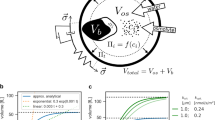Abstract
We present a model for the regulation of the G1/S transition by cell growth in budding yeast. The model includes a description of cell size, the extracellular nutrient concentration and a simplified model of the G1/S transition as originally reported by Chen et al. [Mol. Biol. Cell 11:369–391, 2000]. By considering cell growth proportional to cell size we show that the cell grows exponentially. In the case where cell growth is considered proportional to the concentration of a sizer protein within the cell, our model exhibits both exponential and linear cell growth for varying parameter values. The effects of varying nutrient concentration and initial cell size are considered in the context of whether progression through the cell-size checkpoint occurs. We consider our results in relation to recent experimental evidence and discuss possible experiments for testing our theoretical predictions.
Similar content being viewed by others
References
Alberts, B., Bray, D., Lewis, J., Raff, M., Roberts, K., Watson, J., 1994. Molecular Biology of the Cell, 3rd edition. Garland Publishing, New York.
Boye, E., Nordström, K., 2003. Coupling the cell-cycle to cell growth. EMBO Rep. 4, 757–760.
Brooks, R., 1996. Variability in the cell cycle and the control of proliferation. In: John, P. (Ed.), The Cell Cycle. Cambridge University Press, Cambridge, UK.
Chen, K., Csikasz-Nagy, A., Gyorffy, B., Val, J., Novak, B., Tyson, J., 2000. Kinetic analysis of a molecular model of the budding yeast cell cycle. Mol. Biol. Cell 11, 369–391.
Chen, K., Calzone, L., Csikasz-Nagy, A., Cross, F., Novak, B., Tyson, J., 2004. Integrative analysis of cell cycle control in budding yeast. Mol. Biol. Cell 15, 3841–3862.
Conlon, I., Raff, M., 1999. Size control in animal development. Cell 96, 235–244.
Conlon, I., Raff, M., 2003. Differences in the way a mammalian cell and yeast cells coordinate cell growth and cell-cycle progression. J. Biol. 2(7), 1–10.
Cross, F., Archambault, V., Miller, M., Klovstad, M., 2002. Testing a mathematical model of the yeast cell cycle. Mol. Biol. Cell 13, 52–70.
David-Pfeuty, T., 1999. Potent inhibitors of cyclin-dependent kinase 2 induce nuclear accumulation of wild-type p53 and nucleolar fragmentation in human untransformed and tumour-derived cells. Oncogene 18, 7409–7422.
Degterev, A., Boyce, M., Yuan, J., 2003. A decade of caspases. Oncogene 22, 8543–8567.
Jin, Y., Yim, H., Park, J., Lee, S., 2003. Cdk2 activity is associated with depolarisation of mitochondrial membrane potential during apoptosis. Biochem. Biophys. Res. Commun. 305, 974–980.
Lukovic, A., Komoriya, A., Packard, B., Ucker, D.S., 2003. Caspase activity is not sufficient to execute cell death. Exp. Cell Res. 289, 384–395.
Nasmyth, K., 1996. At the heart of the budding yeast cycle. Trends Genet. 12, 405–412.
Nielsen, L., Reid, S., Greenfield, P., 1997. Cell cycle model to describe animal cell size variation and lag between cell number and biomass dynamics. Biotech. Bioeng. 56(4), 372–379.
Nishioka, W., Welsh, R., 1994. Susceptibility to cytotoxis t lymphoctye-induced apoptosis is a function of the proliferative status of the target. J. Exp. Med. 179, 769–774.
Novak, B., Csikasz-Nagy, A., Gyorffy, B., Chen, K., Tyson, J., 1998a. Mathematical model of the fission yeast cell cycle with checkpoint controls at the G1/S, G2/M and metaphase/anaphase transitions. Biophys. Chem. 72, 185–200.
Novak, B., Csikasz-Nagy, A., Gyorffy, B., Nasmyth, K., Tyson, J., 1998b. Model scenarios for evolution of the eukaryotic cell cycle. Phil. Trans. R. Soc. Lond. B 353, 2063–2076.
Novak, B., Tóth, A., Csikász-Nagy, A., Györffy, B., Tyson, J., Nasmyth, K., 1999. Finishing the cell cycle. J. Theor. Biol. 199, 223–233.
Nurse, P., Thuriaux, T., Nasmyth, K., 1976. Genetic control of the cell division cycle in the fission yeast S. pombe. Mol. Gen. Genet. 146, 377–386.
Padmanabhan, J., Park, D., Greene, L., Shelanski, M., 1999. Role of cell cycle regulatory proteins in cerebral granule neuron apoptosis. J. Neurosci. 19, 8747–8756.
Rupeš, I., 2002. Checking cell size in yeast. Trends Genet. 18(9), 479–485.
Tecarro, E., Obeyesekere, M., Auchmuty, G., 2003. Mathematical analysis of a 3-variable cell cycle model. Nonlinear Anal. 4(9), 87–107.
Tyson, J., 1999. Models of cell cycle control in eukaryotes. J. Biotech. 71, 239–244.
Tyson, J., Novak, B., 2001. Regulation of the eukaryotic cell cycle: Molecular antagonism, hysteresis, and irreversible transitions. J. Theor. Biol. 210, 249–263.
Tyson, J., Novak, B., Odell, G., Chen, K., Thron, C., 1996. Chemical kinetic theory: Understanding cell-cycle regulation. TIBS 21, 89–96.
Varma, A., Morbidelli, M., Wu, H., 1999. Parametric Sensitivity in Chemical Systems. Cambridge University Press, New York.
Yaglom, J., Linskens, M., Sadis, S., Rubin, D., Futcher, B., Finley, D., 1995. p34-Mediated control of cln3 cyclin degradation. Mol. Cell Biol. 15(2), 731–741.
Author information
Authors and Affiliations
Corresponding author
Additional information
Both authors contributed equally to this article.
Rights and permissions
About this article
Cite this article
Alarcón, T., Tindall, M.J. Modelling Cell Growth and its Modulation of the G1/S Transition. Bull. Math. Biol. 69, 197–214 (2007). https://doi.org/10.1007/s11538-006-9154-0
Received:
Accepted:
Published:
Issue Date:
DOI: https://doi.org/10.1007/s11538-006-9154-0




